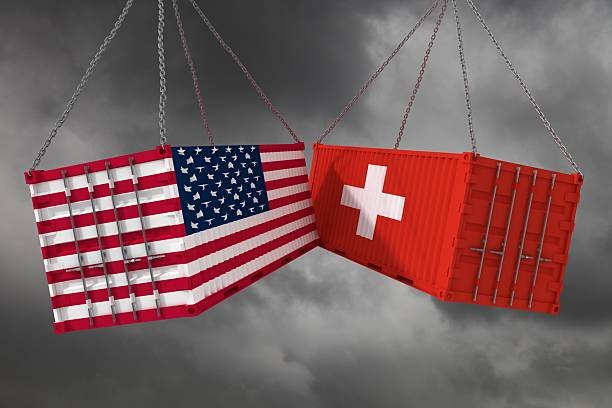The United States will cut tariffs on Swiss goods to 15% from the crushing 39% level under a new trade agreement that also commits Swiss companies to invest $200 billion in the U.S. by 2028. Switzerland announced the framework on Friday, calling it one of its most significant trade breakthroughs in recent years.
Swiss Economy Minister Guy Parmelin said the deal “puts Switzerland on an equal footing with the European Union and brings the tariff level down from 39% to 15%,” adding that the agreement directly affects about 40% of Switzerland’s exports. He admitted Switzerland “would prefer (the $200 billion) to be invested in Switzerland,” noting that officials are working to reduce costs at home to keep industries competitive.
U.S. Trade Representative Jamieson Greer said the White House would publish full details later in the day, framing the deal as a win for American industry. Helene Budliger Artieda, who heads Switzerland’s State Secretariat for Economic Affairs, said the new tariff rate would take effect within “days, weeks,” once customs systems are updated.
Also Read:
- US Tariffs on Gold Bars Drive Futures to Record High, Threaten Switzerland’s Refining Industry
- US Court Slams Trump's Global Tariffs, Rules Them Illegal
- Trump Tariffs: How Trumps Ongoing Trade war May Force the U.S. Economy Into a Recession
- Apple to Invest $500 Billion in U.S Amid Trumps Tariffs On Chinese Imports
She noted that much of the Swiss investment in the U.S. would flow from pharmaceuticals and life sciences, although she offered no further detail. Pharmaceuticals remain Switzerland’s biggest export category to the United States.
More Manufacturing Moves to America
Greer told CNBC the agreement would push Swiss companies to shift “a lot of manufacturing here to the United States – pharmaceuticals, gold smelting, railway equipment.” He said the White House expects the move to create new momentum in American manufacturing and supply chains.
The deal’s emphasis on drug production reflects the strategic importance of Swiss pharma giants Roche and Novartis, whose exports face rising pressure from new U.S. national security tariffs.
15% Ceiling on Pharma Tariffs
A key part of the agreement is a cap on future U.S. Section 232 tariffs, limiting duties on Swiss drugmakers to 15%. The cap shields Switzerland from potential penalties of up to 100% on patented medicines, which were being considered under President Donald Trump’s new tariff plans.
Parmelin stressed that the ceiling applies not just to pharmaceuticals but also to future sector-specific tariffs, such as those targeting semiconductors, placing Switzerland on the same level as the EU. “The risk of much higher sector-specific tariffs is therefore ruled out,” he said.
In exchange, Switzerland will lower its own duties on selected American industrial goods, seafood, and agricultural products it considers non-sensitive. The deal also gives U.S. exporters duty-free bilateral tariff quotas on 500 tons of beef, 1,000 tons of bison meat, and 1,500 tons of poultry meat.
The Swiss government said the agreement also covers neighboring Liechtenstein, aligning both countries more closely with U.S. trade rules.
Industry Relief at Home
Swiss manufacturers welcomed the agreement, describing it as overdue protection against competitive losses. Nicola Tettamanti, head of Swissmechanic, said: “For the industrial sector, which was subject to a 39% tariff since August 1, this is good news. For the first time, we have the same conditions in the U.S. market as our European competitors.”
Still, some analysts warned of long-term risks. Hans Gersbach of the KOF Swiss Economic Institute said the tariff relief is substantial, but “additional economic burdens and risks for Switzerland remain,” especially for exporters dependent on U.S. demand.
Growth Boost Expected
Sectors such as machinery, precision instruments, watchmaking, and food production are expected to gain the most from the tariff reduction. Gersbach said KOF’s current Swiss growth forecast of 0.9% for 2026 could rise beyond 1% under the new tariff regime.
Swiss trade data shows the country had a goods trade surplus of $38.3 billion with the U.S. in 2024, rising to $55.7 billion in the first seven months of 2025 as companies front-loaded shipments before U.S. tariffs hit in April.
Economist Nadia Gharbi of Pictet said the tariff cut removes the biggest short-term threat to Switzerland’s export economy. She noted that Switzerland “suffered a significant loss of competitiveness, not only because of the strength of the Swiss franc, but also because neighboring European economies were subject to tariffs of only around 15%.”
The pressure was already visible: Swiss industry reported a 14% drop in exports to the U.S. from July to September, while machine tool makers suffered a steep 43% decline, according to Swissmem.






















